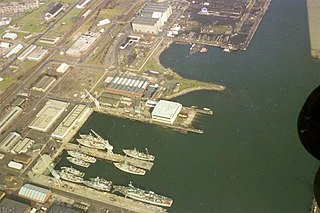Eleven ships and a shore establishment of the Royal Navy have been named HMS Medway, after the River Medway.
Twelve ships and two shore establishments of the Royal Navy have been named HMS Defiance. Others have borne the name whilst serving as depot ships and tenders to the establishments:
Ten ships of the Royal Navy have been named HMS Royalist:

Rosyth Dockyard is a large naval dockyard on the Firth of Forth at Rosyth, Fife, Scotland, owned by Babcock Marine, which formerly undertook refitting of Royal Navy surface vessels and submarines. Before its privatisation in the 1990s it was formerly the Royal Naval Dockyard Rosyth. Its primary role now is the dismantling of decommissioned nuclear submarines. It is also the integration site for the Royal Navy's newest aircraft carriers, the Queen Elizabeth class as well as the Type 31 Frigate.
Nineteen ships and a shore establishment of the Royal Navy have been named HMS Drake after Sir Francis Drake or after the drake:
Numerous Royal Navy vessels have been named HMS Dolphin after the dolphin.
Five ships and two establishments of the Royal Navy, and one ship of the Royal Indian Navy have borne the name HMS Indus, after the Indus River:
Nine ships and a number of shore establishments of the Royal Navy have been named HMS Pembroke.

Eighteen ships of the Royal Navy have borne the name HMS Mercury, or HMS Mercure, after the God Mercury, of Roman mythology:
A ship and a shore establishment of the Royal Navy have borne the name HMS Excellent:

HMS Ganges was a training ship and later stone frigate of the Royal Navy. She was established as a boys' training establishment in 1865, and was based aboard a number of hulks before moving ashore. She was based alternately in Falmouth, Harwich and Shotley. She remained in service at RNTE Shotley until October 1976.

The Condor class was a six-ship class of 10-gun screw steel sloops built for the Royal Navy between 1898 and 1900. Condor foundered in a gale, prompting the Royal Navy to abandon sailing rigs for its ships. The last of the class, Mutine, survived until 1932 as a Royal Naval Volunteer Reserve drill ship.
Five ships and a number of shore establishments of the British Royal Navy have borne the name HMS Wildfire:

The Astraea class was an eight ship class of protected cruisers built for the Royal Navy during the 1890s. The ships served on a number of foreign stations during their careers, particularly in the waters of the Indian and Pacific Oceans, and around the Cape of Good Hope. Already obsolete by the outbreak of the First World War, most continued to see service in a variety of roles, though rarely in a front line capacity. By the end of the war the majority were being used as training or depot ships, and they were soon sold out of the service and scrapped. However one ship, HMS Hermione, was bought by the Marine Society and used as a training ship until 1940.
Four ships of the Royal Navy have borne the name HMS Cuckoo, after the cuckoo, a family of birds:

HMS Elfin was a torpedo recovery vessel built for the Royal Navy. She was built by J. Samuel White & Company, East Cowes, Isle of Wight, was launched on 20 November 1933 and commissioned on 16 January 1934. She was builder's number 1754. Her home port was the Navy's torpedo trials establishment HMS Vernon, and she was based at Portland. A sistership, Redwing, was constructed under builder's number 1753 and was stationed at HMS Defiance, Devonport. Elfin was renamed Nettle during the Second World War, and was later sold for scrapping. She survived in mercantile service, and has been preserved.
HMS Vivid was the Royal Navy designation for the barracks at Devonport in England and for other nominal bases in Cornwall, Ireland and Wales.
HMS Vivid was an iron screw yacht purchased from civilian service in 1891, where she had been named SS Capercailzie. She became the Devonport base ship and flagship in 1893 and was also used as the yacht for the Commander-in-Chief, Plymouth and was sold in 1912, later being wrecked in 1913.
This page is based on this
Wikipedia article Text is available under the
CC BY-SA 4.0 license; additional terms may apply.
Images, videos and audio are available under their respective licenses.





